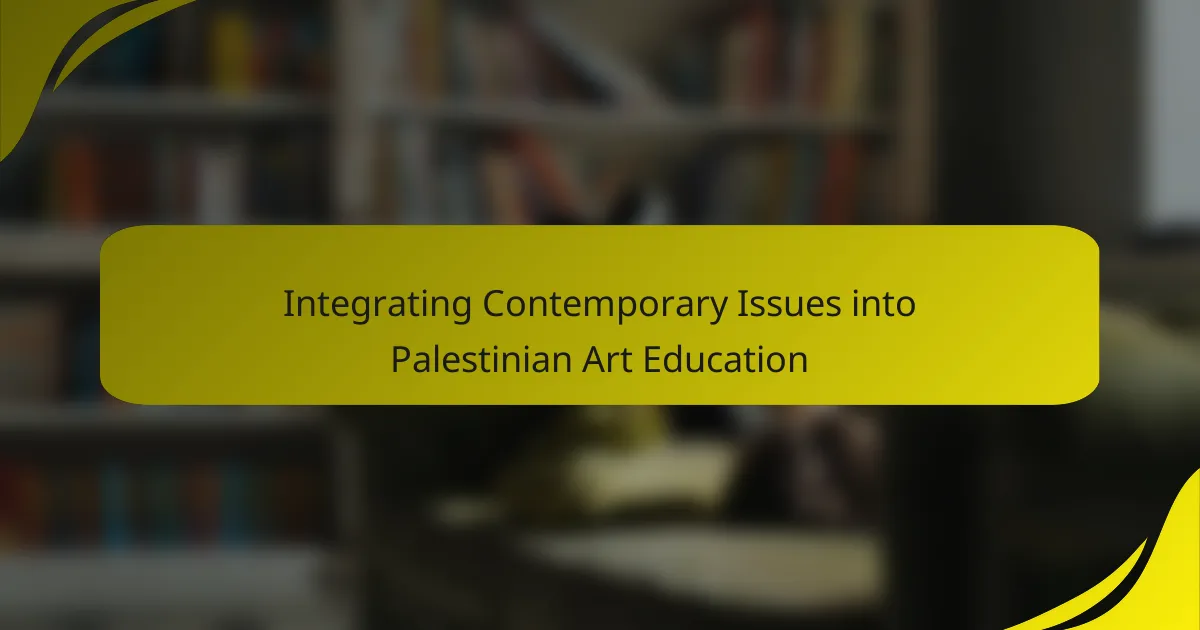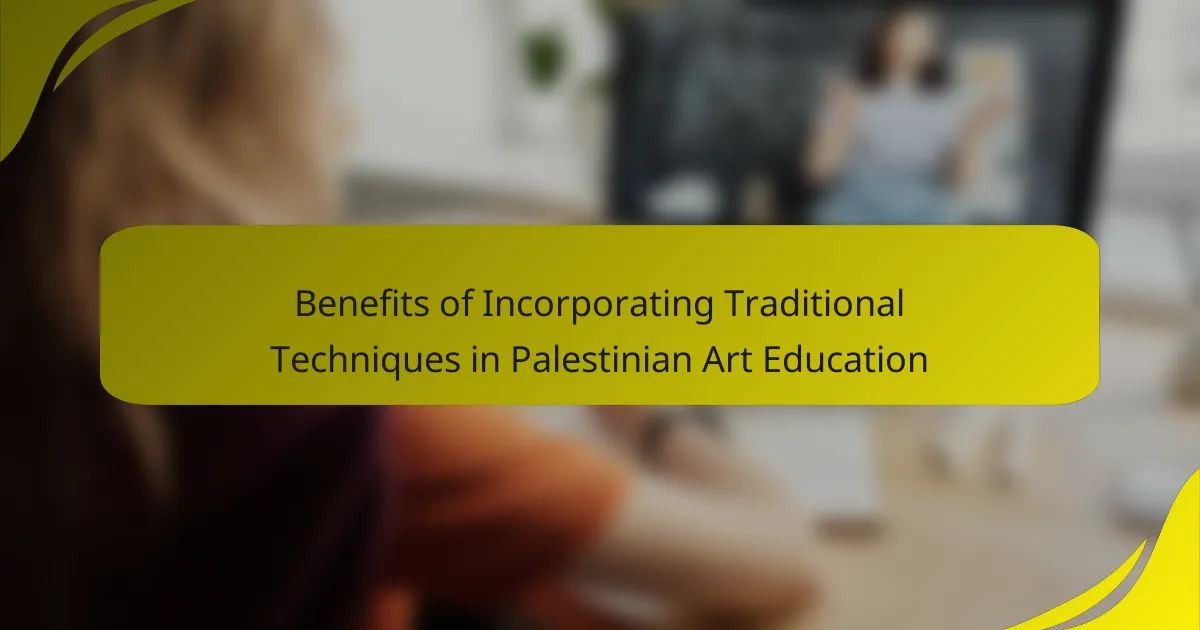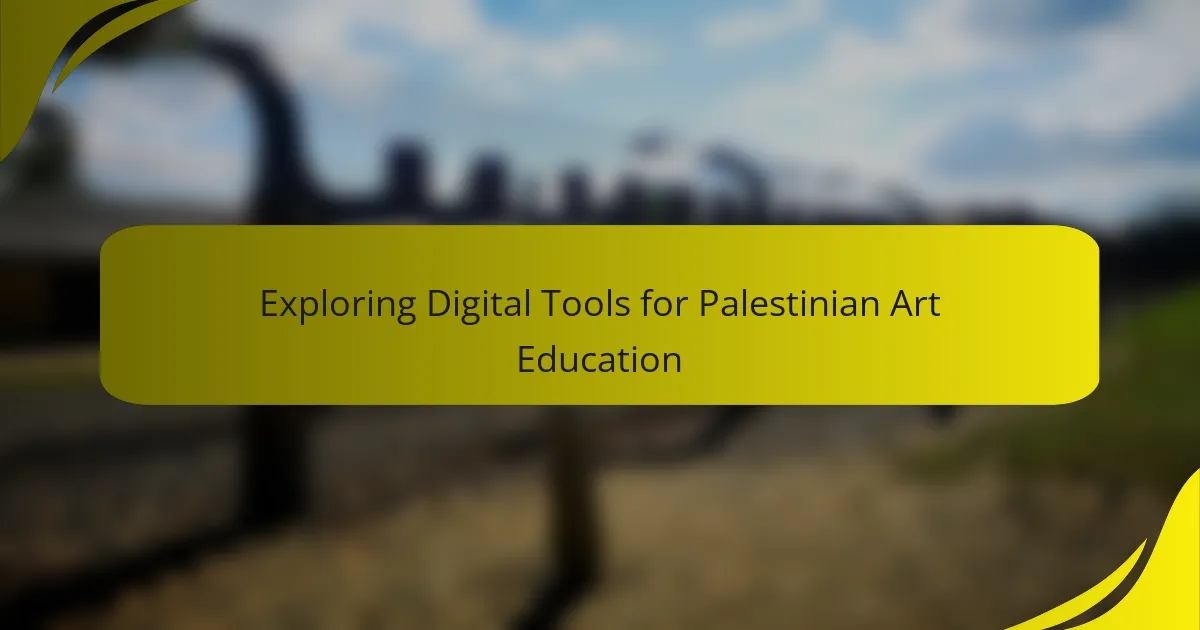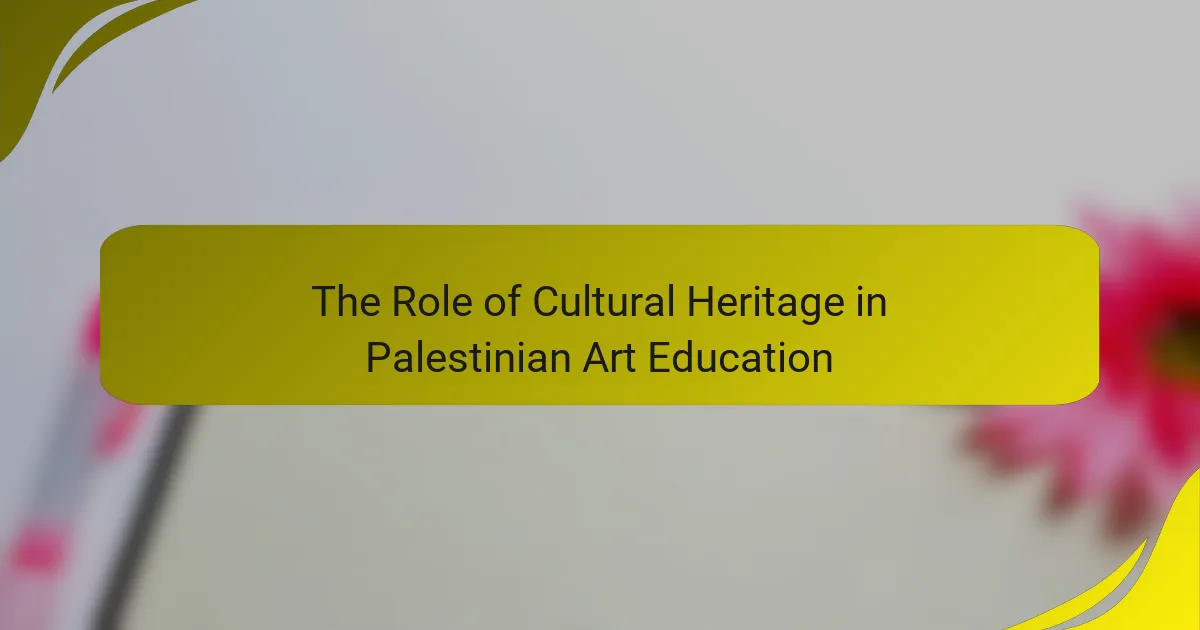Assessment methods in Palestinian art education encompass formative and summative assessments, vital for evaluating student progress and understanding. Formative assessments, such as portfolios, peer reviews, and self-assessments, provide ongoing feedback and foster student engagement, creativity, and self-reflection. Summative assessments evaluate overall achievement at the end of a learning period. The article highlights the significance of these assessment techniques in supporting artistic skill development and critical thinking, emphasizing the need for diverse evaluation strategies to enhance learning outcomes in the unique cultural and political context of Palestine.
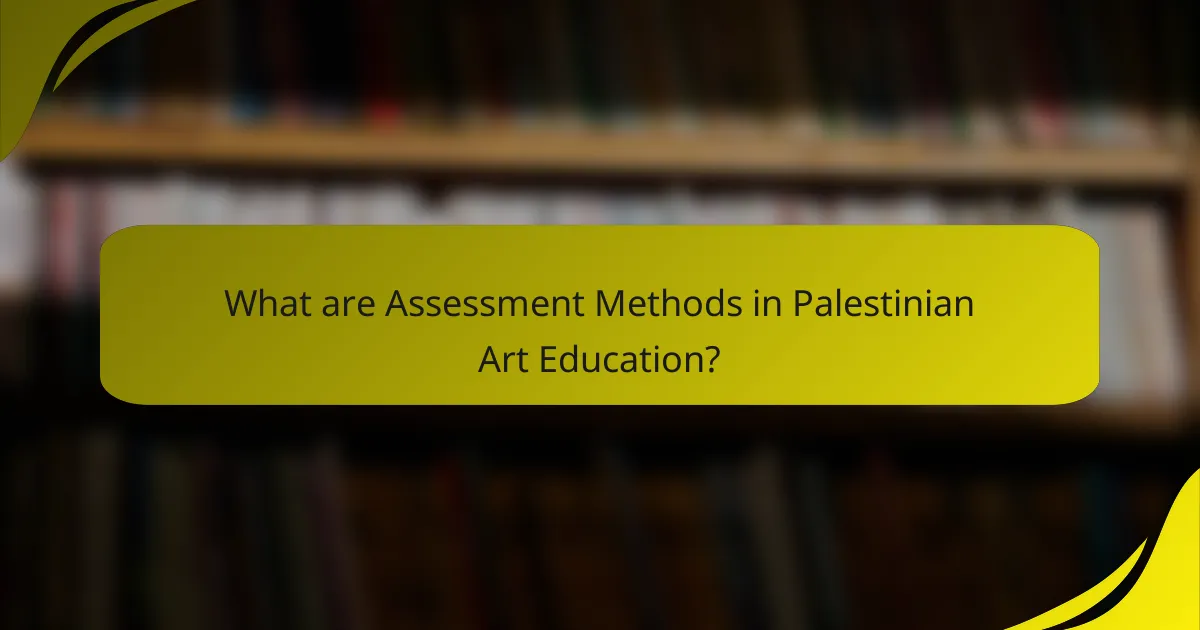
What are Assessment Methods in Palestinian Art Education?
Assessment methods in Palestinian art education include formative and summative assessments. Formative assessments are ongoing evaluations that occur during the learning process. These assessments help educators gauge student progress and provide feedback. Summative assessments occur at the end of a learning period to evaluate overall achievement. Common techniques include portfolios, peer reviews, and self-assessments. Portfolios showcase students’ work over time, reflecting their growth and skill development. Peer reviews encourage collaboration and critical thinking among students. Self-assessments promote self-reflection and personal growth in artistic skills. These methods are essential for fostering creativity and critical engagement in art education.
How do these assessment methods contribute to student learning?
Assessment methods enhance student learning by providing feedback and promoting self-reflection. These methods help identify students’ strengths and weaknesses in their artistic skills. They also encourage critical thinking by requiring students to analyze their work and that of their peers. Formative assessments, such as peer reviews, foster collaboration and communication among students. Summative assessments evaluate overall learning and mastery of concepts. Research shows that regular assessments can lead to improved academic performance. According to a study by Black and Wiliam (1998), effective assessment practices significantly boost student achievement.
What are the key components of effective assessment in art education?
Key components of effective assessment in art education include clear objectives, diverse assessment methods, and constructive feedback. Clear objectives guide students on what is expected in their artistic development. Diverse assessment methods, such as portfolios, peer reviews, and self-assessments, cater to different learning styles and artistic expressions. Constructive feedback helps students understand their strengths and areas for improvement, fostering growth. Research indicates that assessments aligned with learning objectives enhance student engagement and achievement in art education.
How do cultural contexts influence assessment methods?
Cultural contexts significantly influence assessment methods by shaping the criteria and standards used in evaluations. Different cultures prioritize various artistic values and expressions, which affects how art is perceived and judged. For instance, in Palestinian art education, cultural narratives and historical experiences inform the content and themes of student work. This cultural backdrop leads to unique assessment criteria that may not align with Western standards. Furthermore, community involvement in the assessment process often reflects local traditions and values. Research shows that culturally responsive assessment practices improve student engagement and learning outcomes. Overall, cultural contexts provide a framework that guides the development and implementation of assessment methods in art education.
What types of assessment methods are utilized in Palestinian art education?
Palestinian art education utilizes various assessment methods. These methods include formative assessments, summative assessments, and peer assessments. Formative assessments are ongoing evaluations that provide feedback during the learning process. They often involve critiques of student work and reflections on artistic development. Summative assessments evaluate student learning at the end of an instructional unit. These assessments can include final projects or exhibitions. Peer assessments allow students to evaluate each other’s work, fostering collaboration and critical thinking. Research indicates that these methods help enhance artistic skills and promote a deeper understanding of art among students.
How do formative assessments differ from summative assessments?
Formative assessments are ongoing evaluations used to monitor student learning and provide feedback. They occur during the learning process and aim to improve student performance. Examples include quizzes, class discussions, and peer reviews. Summative assessments evaluate student learning at the end of an instructional period. They typically occur after a unit or course and measure overall achievement. Examples include final exams, standardized tests, and end-of-term projects. The key difference lies in their timing and purpose: formative assessments guide learning, while summative assessments measure it.
What role do self-assessments play in student development?
Self-assessments play a crucial role in student development by fostering self-awareness and reflection. They encourage students to evaluate their own work and progress. This process helps them identify strengths and areas for improvement. Research indicates that self-assessment enhances critical thinking skills. According to a study published in the Journal of Educational Psychology, students who engage in self-assessment demonstrate higher academic performance. Self-assessments also promote ownership of learning, making students more accountable for their educational journey. Overall, they are integral to developing independent, reflective learners in the context of Palestinian art education.
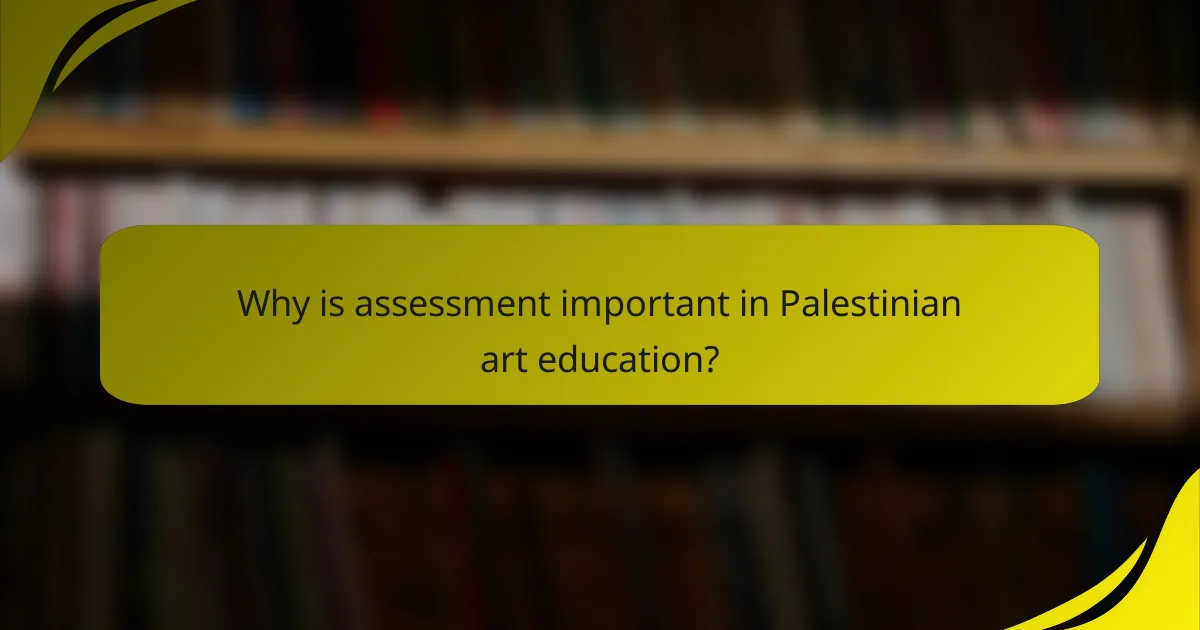
Why is assessment important in Palestinian art education?
Assessment is important in Palestinian art education because it measures student progress and understanding. It helps educators identify strengths and weaknesses in artistic skills. Assessment also provides feedback that guides teaching methods and curriculum development. In a region with unique cultural and political contexts, it ensures that art education is relevant and responsive. Furthermore, assessment fosters critical thinking and creativity among students. It encourages self-reflection and personal growth in artistic expression. Ultimately, effective assessment in Palestinian art education supports the development of a vibrant artistic community.
How do assessments impact artistic expression and creativity?
Assessments can significantly influence artistic expression and creativity. They often impose structured criteria that may limit spontaneous artistic exploration. When students focus on meeting assessment standards, their creative risk-taking may diminish. Research indicates that strict assessment methods can lead to anxiety, hindering creative output. Conversely, formative assessments that encourage feedback can foster creativity. Such assessments promote reflection and iterative improvement in artistic practices. Ultimately, the nature of assessments shapes the degree to which students feel free to express themselves artistically.
What are the benefits of incorporating peer assessments?
Incorporating peer assessments enhances learning outcomes and fosters critical thinking. It encourages students to engage in collaborative learning. This method promotes self-reflection as students evaluate their peers’ work. Research indicates that peer assessments can improve students’ understanding of assessment criteria. A study by Topping (1998) found that peer feedback can enhance academic performance. Additionally, peer assessments build communication skills through constructive feedback. They also create a sense of ownership in the learning process. Overall, peer assessments contribute to a more interactive and participatory educational environment.
How can assessments guide curriculum development in art education?
Assessments can guide curriculum development in art education by identifying student strengths and weaknesses. They provide data on student progress and learning outcomes. This data helps educators adjust teaching methods and content. Assessments also align curriculum with educational standards and goals. For example, formative assessments can reveal areas needing more focus. Summative assessments can evaluate overall program effectiveness. Research shows that assessment-driven curriculum leads to improved student engagement and achievement. A study by Wiggins and McTighe (2005) emphasizes the importance of backward design in curriculum development, which relies on assessment data.
What challenges are faced in implementing assessment methods?
Implementing assessment methods in Palestinian art education faces several challenges. Limited resources hinder the development of effective assessment tools. Inconsistent training for educators affects their ability to assess students accurately. Cultural factors may influence perceptions of assessment and its importance. Additionally, the lack of standardized criteria complicates fair evaluations. Resistance to change can impede the adoption of new assessment methods. Finally, logistical issues, such as insufficient time for assessments, create further obstacles. These challenges collectively impact the effectiveness of assessment in this educational context.
How do resource limitations affect assessment practices?
Resource limitations significantly hinder assessment practices in Palestinian art education. Limited financial resources restrict access to necessary materials and tools for effective assessments. This situation leads to a reliance on less comprehensive assessment methods. Educators may resort to informal assessments due to the lack of structured evaluation tools. Additionally, insufficient training for educators affects their ability to design and implement effective assessments. Studies indicate that resource constraints can lead to lower quality of education outcomes. For example, a lack of art supplies can limit students’ creative expression during evaluations. Overall, resource limitations create a cycle that negatively impacts both teaching and learning in art education.
What strategies can be employed to overcome these challenges?
Implementing collaborative assessments can effectively overcome challenges in Palestinian art education. Collaborative assessments encourage group work and peer feedback. This approach fosters a supportive learning environment. Utilizing diverse assessment methods, such as portfolios and exhibitions, allows for varied student expression. Incorporating community feedback can enhance relevance and engagement. Providing professional development for educators can improve assessment strategies. Research shows that diverse methods increase student motivation and learning outcomes. For instance, a study by Al-Azzeh (2020) highlights the benefits of innovative assessment in enhancing creativity among Palestinian students.
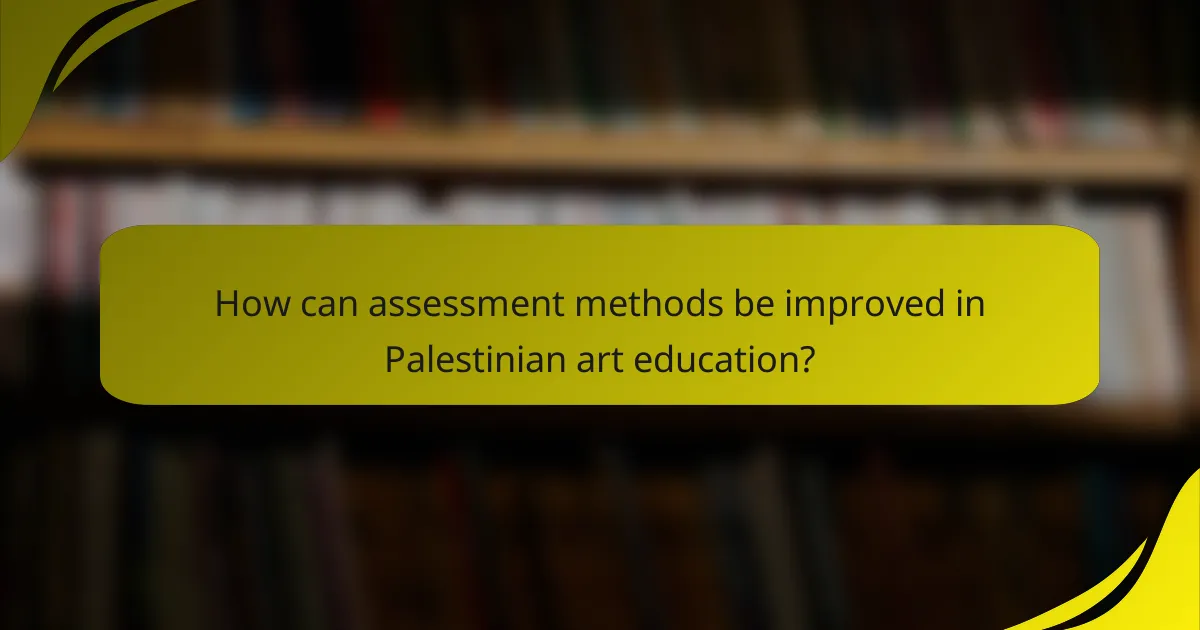
How can assessment methods be improved in Palestinian art education?
Assessment methods in Palestinian art education can be improved by integrating diverse evaluation techniques. Incorporating formative assessments allows for ongoing feedback during the learning process. This can enhance student engagement and creativity. Additionally, utilizing peer assessments fosters collaboration and critical thinking among students. Implementing project-based assessments can provide real-world context and relevance to art education. Moreover, training educators in contemporary assessment strategies ensures they are equipped to evaluate student work effectively. Research indicates that diverse assessment methods lead to better learning outcomes. For instance, a study by the National Art Education Association highlights the benefits of varied assessment approaches in fostering artistic skills.
What best practices can enhance the effectiveness of assessment methods?
Best practices that enhance the effectiveness of assessment methods include aligning assessments with learning objectives. This ensures that evaluations measure the intended skills and knowledge. Incorporating diverse assessment types, such as formative and summative assessments, provides a comprehensive view of student learning. Regular feedback is crucial; it helps students understand their progress and areas for improvement.
Engaging students in self-assessment encourages reflection on their learning processes. Additionally, using rubrics clarifies expectations and provides consistent grading criteria. Finally, involving stakeholders, such as educators and community members, can enrich the assessment process by incorporating diverse perspectives. These practices are supported by educational research emphasizing the importance of alignment, feedback, and diversity in assessment strategies.
How can technology be integrated into assessment practices?
Technology can be integrated into assessment practices through various digital tools and platforms. Online assessment software enables educators to create and administer tests efficiently. Learning management systems facilitate the tracking of student progress and performance. Digital portfolios allow students to showcase their work and receive feedback. Interactive tools like quizzes and polls engage students and provide immediate results. Video assessments enable students to demonstrate skills in real-time. Data analytics can help educators identify trends and areas for improvement. Research indicates that technology-enhanced assessments can lead to more personalized learning experiences. The integration of technology in assessments supports diverse learning styles and enhances engagement.
What training is needed for educators to implement effective assessments?
Educators need training in assessment design, data analysis, and feedback techniques to implement effective assessments. This training should include understanding various assessment types, such as formative and summative assessments. Educators should learn how to create clear learning objectives aligned with assessments. Training should also cover how to analyze assessment data to inform instruction. Additionally, educators need skills in providing constructive feedback to students. Professional development workshops and collaborative learning communities can support this training. Research indicates that well-trained educators significantly improve student outcomes.
What insights can be gained from evaluating current assessment practices?
Evaluating current assessment practices reveals strengths and weaknesses in educational approaches. It helps identify effective methods that enhance student learning outcomes. Insights gained include understanding student engagement levels and how well assessments align with learning objectives. Additionally, evaluation can highlight gaps in assessment tools and inform necessary adjustments. This process can also uncover biases that may affect student performance. For instance, research indicates that formative assessments can improve learning when integrated effectively. By analyzing assessment data, educators can make informed decisions to enhance curriculum design. Overall, evaluating assessment practices leads to improved educational strategies and student success.
How can feedback from students shape future assessment methods?
Feedback from students can significantly shape future assessment methods by providing insights into their learning experiences. It allows educators to understand what assessment strategies are effective and which ones are not. When students express their preferences and challenges, teachers can adapt assessments to better meet learning objectives. Research indicates that student feedback leads to improved engagement and satisfaction in educational settings. A study by Hattie and Timperley (2007) highlights that feedback is a critical component of effective teaching and learning. By incorporating this feedback, educators can create assessments that are more relevant and supportive of student learning. This iterative process enhances the overall quality of education in Palestinian art education.
What role do community and cultural stakeholders play in assessment evaluation?
Community and cultural stakeholders play a crucial role in assessment evaluation by providing context and insights. Their involvement ensures that evaluations are culturally relevant and reflective of community values. They contribute local knowledge that enhances the understanding of educational outcomes. Stakeholders also facilitate communication between educators and the community. This collaboration fosters trust and encourages participation in the evaluation process. Research indicates that stakeholder engagement leads to more effective assessments. For example, studies show that incorporating community perspectives improves the validity of evaluation results. Thus, their role is essential in creating meaningful and accurate assessments in educational settings.
What practical tips can enhance assessment methods in Palestinian art education?
Incorporating diverse assessment methods can enhance Palestinian art education. Use formative assessments to provide ongoing feedback. This approach allows students to improve their skills continuously. Implement peer assessments to encourage collaborative learning. Students can learn from each other’s perspectives and techniques. Utilize project-based assessments to evaluate creativity and practical application. This method reflects real-world art practices. Include self-assessments to promote personal reflection and growth. This empowers students to take ownership of their learning. Regularly adapt assessment criteria to align with cultural context and artistic goals. This ensures relevance and engagement in the learning process.
Assessment methods in Palestinian art education encompass formative and summative evaluations that facilitate student learning and artistic development. Key techniques include portfolios, peer reviews, and self-assessments, which promote feedback, collaboration, and self-reflection. The article explores how these methods contribute to student engagement, the influence of cultural contexts on assessment criteria, and the challenges faced in implementation. It emphasizes the importance of diverse assessment approaches in guiding curriculum development and enhancing creativity within the educational framework. Additionally, the role of community involvement and student feedback in shaping effective assessment practices is highlighted.
